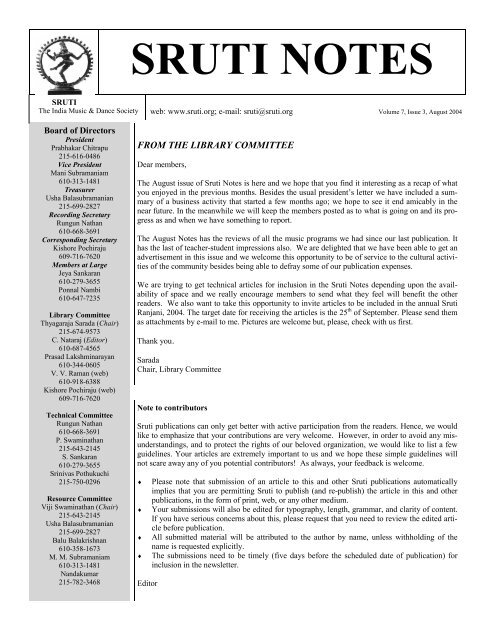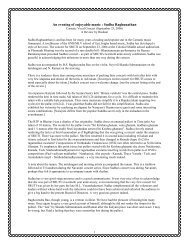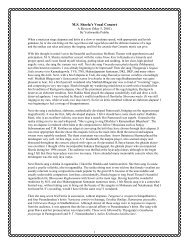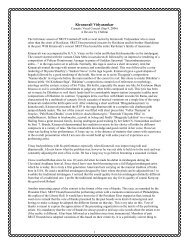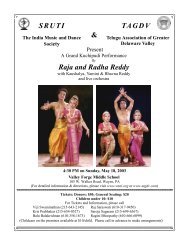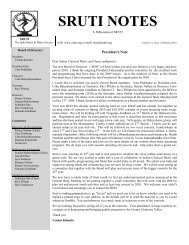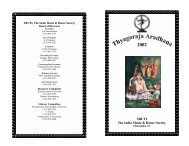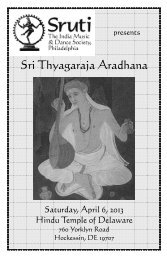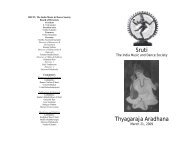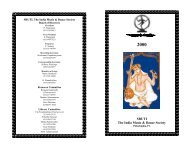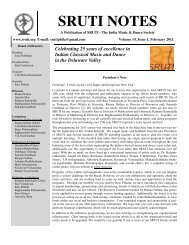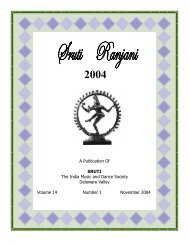Create successful ePaper yourself
Turn your PDF publications into a flip-book with our unique Google optimized e-Paper software.
<strong>SRUTI</strong> <strong>NOTES</strong><strong>SRUTI</strong>The India Music & Dance Societyweb: www.sruti.org; e-mail: sruti@sruti.org Volume 7, Issue 3, August 2004Board of DirectorsPresidentPrabhakar Chitrapu215-616-0486Vice PresidentMani Subramaniam610-313-1481TreasurerUsha Balasubramanian215-699-2827Recording SecretaryRungun Nathan610-668-3691Corresponding SecretaryKishore Pochiraju609-716-7620Members at LargeJeya Sankaran610-279-3655Ponnal Nambi610-647-7235Library CommitteeThyagaraja Sarada (Chair)215-674-9573C. Nataraj (Editor)610-687-4565Prasad Lakshminarayan610-344-0605V. V. Raman (web)610-918-6388Kishore Pochiraju (web)609-716-7620Technical CommitteeRungun Nathan610-668-3691P. Swaminathan215-643-2145S. Sankaran610-279-3655Srinivas Pothukuchi215-750-0296Resource CommitteeViji Swaminathan (Chair)215-643-2145Usha Balasubramanian215-699-2827Balu Balakrishnan610-358-1673M. M. Subramaniam610-313-1481Nandakumar215-782-3468FROM THE LIBRARY COMMITTEEDear members,The August issue of Sruti Notes is here and we hope that you find it interesting as a recap of whatyou enjoyed in the previous months. Besides the usual president’s letter we have included a summaryof a business activity that started a few months ago; we hope to see it end amicably in thenear future. In the meanwhile we will keep the members posted as to what is going on and its progressas and when we have something to report.The August Notes has the reviews of all the music programs we had since our last publication. Ithas the last of teacher-student impressions also. We are delighted that we have been able to get anadvertisement in this issue and we welcome this opportunity to be of service to the cultural activitiesof the community besides being able to defray some of our publication expenses.We are trying to get technical articles for inclusion in the Sruti Notes depending upon the availabilityof space and we really encourage members to send what they feel will benefit the otherreaders. We also want to take this opportunity to invite articles to be included in the annual SrutiRanjani, 2004. The target date for receiving the articles is the 25 th of September. Please send themas attachments by e-mail to me. Pictures are welcome but, please, check with us first.Thank you.SaradaChair, Library CommitteeNote to contributorsSruti publications can only get better with active participation from the readers. Hence, we wouldlike to emphasize that your contributions are very welcome. However, in order to avoid any misunderstandings,and to protect the rights of our beloved organization, we would like to list a fewguidelines. Your articles are extremely important to us and we hope these simple guidelines willnot scare away any of you potential contributors! As always, your feedback is welcome.♦♦♦♦Please note that submission of an article to this and other Sruti publications automaticallyimplies that you are permitting Sruti to publish (and re-publish) the article in this and otherpublications, in the form of print, web, or any other medium.Your submissions will also be edited for typography, length, grammar, and clarity of content.If you have serious concerns about this, please request that you need to review the edited articlebefore publication.All submitted material will be attributed to the author by name, unless withholding of thename is requested explicitly.The submissions need to be timely (five days before the scheduled date of publication) forinclusion in the newsletter.Editor
Dear Sruti Friends:From the President’s DeskI hope you are all having a safe and enjoyable summer!As you know, we have completed a busy and successful springseason of concerts and events. They consisted of 1) ThyagarajaAradhana, 2) Hindusthani Concert of Ustad Shujaat Khan(Sitar) & Pandit Debashish Bhattacharya (Slide Guitar), 3)Carnatic Vocal Concert by Vijaya Siva, 4) Flute Workshop &Mini-Concert by Dr. N. Ramani, 5) a Carnatic Violin Concertby Smt. A. Kanyakumari and 6) Tabla and Sitar Concert byShafaatullah Khan. That averages to more than 1 concert amonth! We hope you attended and enjoyed the events. Welook forward to continuing support and patronage.We have an equally attractive and busy Fall season in theworks. Our first event will be a Carnatic Vocal Concert bySanjay Subrahmanian on 11 September, whose details areprovided in the accompanying flyer. Please make every effortto attend and bring your family and friends along. There isnothing that is more satisfying for the organizers and performersthan to see a big audience.This will be followed by a South Indian dance productioncalled Gajamukha, by Dr. Jayanthi Raman and troupe. Withdancers and musicians from India and USA, this is a majorevent for us, which we are cosponsoring with Drexel Universityon October 9. The next event will be a unique CarnaticRhythm Ensemble Concert led by legendary Padma BhushanUmayalpuram Sivaraman on October 30. The next event willbe our annual Sruti Day, providing a forum for showcasingour local talent in music and dance. We are tentatively targetingNov 20 for this event. We plan to cap the year with a rareevent in which our local music teacher/musician Sri T.N. Balawill present with his students his own composition set calledMuruga Rathnakaram. Written in Tamil, these are musicallyrelated to Saint Thyagaraja’s Ghana Raga Pancharathnas andwill especially appeal to our Tamil speaking friends. Thisevent will combine a General Body meeting, which will alsoserve as our “mid term review” by you!The Resource Committee, the Library Committee and theTechnical Committee have been diligently working away andproviding us with, among other things, funds, publications andCD recordings respectively. The By-Laws Ad-Hoc committeeis progressing with its assignment and is expected to submittheir report to the BoD in September time frame. Our sincerethanks to all of them.I look forward to seeing you all at the upcoming Sruti events!With warm regards and thanks,Prabhakar Chitrapu, President.Shafaatullah Khan on Sitar and Tabla: A ReviewKalpana PatankarOn July 11 th, Shafaatullah Khan delighted the audience with ascintillating tabla solo and a sitar concert at the InternationalHouse, Philadelphia. Shafaatji delivered an elegant and inspiredperformance embellished by the melodious sarangi accompanimentof Pandit Ramesh Mishra. Peshkar – ancient compositionsand improvisations in slow teentaal (16 beat rhythm cycle)were executed with precision. Shafaatji has been well indoctrinatedin this art by his teacher Ustad Ibrahim Khansaheb.The pace steadily picked up. In madhya laya listeners werefurther entranced by intricate patterns ending with chakradartihais (patterns of three played three times in succession) whichwere accurate to the millisecond. The legacy of Rampur, Farrakhabad,and other Gharanas of tabla masters were enthusiasticallypresented by Shafaatji’s deft fingers. This section wasinterspersed by many pieces which were simultaneously recitedand played at a fast clip! The fast beat had four beat rhythmswith dramatic off and on beat improvisations ending with athunderous climax! He was accompanied on tanpura by hisstudents Devi and Anjani.What a treat this was for an audience that had already seen anexcellent documentary on the tabla by Ustad Zakir Hussain.This concert was like a double header with shifting emphasis!After intermission, Shafaatji displayed his mastery on the sitar.For a performer to have the ability to deliver both at this level isunique as most exponents of classical Indian music focus onone instrument. He executes a gayaki or vocal style of sitarplaying. He is the eighth generation torch bearer of India’sillustrious dynasty of sitarists. He was instructed in highly disciplinedfashion from very young age by his father, Ustad ImratKhan. Raga Khamaj was introduced in the slow movement ofalaap. Moving on to jod, Shafaatji elaborated fluid meend andgamak techniques with left hand while the right hand playedfast rhythmic patterns using the main and chikari strings. Beinga light and romantic Raga, he chose to play it in a happyplayful mood with lot of delicate krintans that brought lightovertones. A medium speed composition in teentaal was followedby a faster paced piece composed by his grandfatherUstad Enayat Khan. Fast taans were played –some with longslides from octave to octave, others with meend and gamak.The final phase was jhala in ultra fast or ati drut pace whichended with a masterful climax. Amit Das accompanied him ontabla, along with Ambika and Priyanka on the tanpura. Afterthe standing ovation, I heard a comment made by a connoisseurof guitar who was sitting behind me: “Is he the Jimmi Hendrixof Sitar?”I do know that he is a dedicated musician who devotes his timeperfecting his art and believes in passing it on to many students.We are fortunate to have him reside in the Delaware Valleywhen he is not performing around the world in other respectedvenues.The opinions expressed by the contributors of articles and reviews are published in a spirit of openness of communication andfreedom of expression. They do not necessarily reflect the views of Sruti's Board or its members.2
Classical Music in USA: Teacher PerspectivesA series continued from the previous issueT. N. BalaCarnatic music has been my pastime and hobby all my workingyears which turned into a passion since my retirement. During thepast thirty-four years, I had the privilege of teaching music to ahost of students, young and old, men and women, adults and children,mostly in this country. For several years I used to travelevery weekend to many places in the east coast for music sessionswith my student groups as well as individuals.My passion has its deep root in my belief that there is music inevery one of us. It is like a seed buried in us waiting to bloom ifone could dig it out and nurture it. The time it takes to bloomdepends on how deep the seed is buried. I also believe that musicis one source available to every human being to experience absolutepeace of mind and tranquility. This experience is sometimesintellectual, other times emotional. While the science and grammarof music may appeal to the intellectual, the enjoyment ofmusic is emotional as it is universal. It is in this emotional appeal,I believe, absolute music thrives. If I was an instrument intransmitting this emotional appeal to my students, adults or children,I rest contended having earned their respect.This brings us to the role a teacher can play in encouraging theappreciation of our carnatic music system. If you ask me, the firstprerequisite of a teacher is to have been himself or herself a seriousstudent. It teaches such a teacher the value of patience, perseveranceand compassion. I shall never forget how my teacher hadto put up with my inadequacies and forgave me many times towin his love and respect. Let us not lose sight that the greatestreward and satisfaction a teacher gets is the love and respect fromone’s students.The next requisite is the awareness that one ceases to be a teacherif he or she stops listening to or learning from his or her students.It is a two-way channel of communication which reinforces understandingof each other’s limitations. This may seem contrary tothe traditional belief that the student is at the receiving end andhas no say in the matter. On the contrary, my experience is themore a teacher gives the more the love and respect he receivesfrom his disciples. The attribute of a good teacher, as I see it, isnot necessarily to be a strict disciplinarian but to be a compassionateand understanding companion to the student.The third and the last requisite of an understanding teacher is tobe constantly updated and keep an open mind to receive newknowledge and discard obsolete values. Being a student myself,I claim no expertise to advise any one in this area except to reiteratethat the above-mentioned requisites be respected and adheredto. I acknowledge it is quite a challenge to undertake the task ofteaching a very complex and complicated system of music tochildren growing in a different cultural environment with little orno exposure to the tradition or musical sound or experience.Teachers embarking on this arduous assignment to keep con-nected to the roots of our culture are to be applauded for theirdedication.Back home when I was in India recently, I had an opportunityto briefly teach some students, especially young ones. Theproblems of accent, intonation, musical expression, mannerisms,gestures were not so acute as I find in young studentshere in US. It is understandable. Teachers as well as listenersget used to the inadequacies of our children with respect to theabove values in our music. The teacher develops a kind ofacceptance to whatever is possible without sacrificing thespirit and semantics of our musical system.At the same time, in India, I had the occasion to meet withmusic teachers as well who were curious to know about mystudents and how they par with their students. Though I didnot want to minimize the problems of music teachers in nativeenvironment, there were some advantages for them, despitemany similarities in their approach. Students in US, particularly,children, encounter some unique handicaps which needto be addressed specifically by the teacher. It is understandablein that each child or young student has many demands toconfirm during their formative learning years living in a faroff land. It is a demand that does not exist back home. Besides,back home, the cultural living togetherness promotesnative artistic values in a child, for that matter, even in adults.It is very difficult, if not impossible, to simulate such an environmentin a foreign land. This is not to deny that, may be,one in ten may have an inherent gift or innate talent to masterany art, whatever be the environmental conditioning. But, byand large, it is a task that the teacher has to focus on by devisingways and means to simulate the conducive climate tothe student to appreciate and learn.As for the traditional basic learning of notes or swaras, followedby progressive exercises leading up to more advancedrendition of different scales of melodies etc, those lessonsand exercises by themselves do not necessarily create an appreciationor an appeal to a learner. Real interest does not sinkin unless and until it is followed by a feeling of some accomplishmenton the part of the learner. There is a built-in monotonyat the initial stages which the learner has to overcome. Itis the teacher who has to make it happen and to make it interestingand challenging. The teacher has to remember thatoverly engaging in unrealistic expectation would only breedin frustration and fatigue. Besides it will discourage the enthusiasmof the recipient.Speaking for myself as a teacher in a foreign land, I sometimesend up having to teach carnatic music to children, andadults as well, who are geared by a mere drive or passion tolearn the music with little or no cultural background. By ascore of eight in a scale of one to ten, their zeal and curiosity(Continued overleaf)3
(Continued from overleaf)in most cases surpass their ear or talent for music. Merely a musicalscale of seven notes corresponding to seven basic notes ina keyboard instrument like harmonium seems to be the only basisfor their understanding and appreciation of a musical systemotherwise so profound in its import and appeal.On such occasions, I do undertake the task of taking the uninitiatedthrough a thorny path of unfamiliar territory towards a landof pleasant green pasture. For many the appeal ends with thekeyboard representation of a melody. For some the appeal extendsfurther into more subtle ramifications like gamakas,anuswaras, vivadhi swaras of melodies. Only a few transcendthe limitation imposed by the finite musical note. Those are thefew who have had the cultural background and familiarity ofour musical sound. I believe that cultural background can bebrought about by creating simulated environmental changes,even in a class room. There are those who believe that no matterhow long and how much of effort one might take to learn a newsystem, if there was no cultural and environmental conditioning,atleast simulated, the result is usually superficial. Yet there arethose who swear that intense study and total preoccupationwould eventually cover up for the deficiency. Whatever it maybe, I find that appreciation of our music grows very gradually,particularly, in children if they are encouraged to attend, listenand participate in musical events, local or abroad.In my experience, I am amazed to find that a methodical“repetition” or, a better word “japam”, of lessons on a regularbasis brings out the best in every student. I usually seek apromise from the student to spare at least half hour of practicethrice a week. I also tell my students that their best-renderedmusical piece is the one that they had listened to and practicedthe maximum number of times.You should see the glee in their eyes once they are appreciatedand recognized for their genuine effort to be at their best. As ateacher, nothing gives me more fulfillment than to hear my studentsay “ I love your teaching, Mama.”Violin concert by Kanyakumari and Embar Kannan:A ReviewS. SankaranThe concert began well with a Varnam in Natakuranji, followedby a kriti on Lord Ganesha in a traditional way. The third kriti'Sri Viswanantham' (requested by a member before the concert)set the stage for the rest of the concert. (In a recording of thiscomposition done in 1977 by M.L.Vasanthakumari accompaniedby Kanyakumari, its duration was 11 minutes). However,in this concert it was embellished by sangathis added by theartists, and lasted 15 minutes. The artists' virtuosity was evidentin the rendering.The next composition (Dinamani Vamsa) was probably the majorwork in the concert. It was done with a detailed imaginativeAlapana, followed by excellent rendering with creative niravaland karpana swaras. The 2 compositions of Thyagaraja whichfollowed were a pleasant surprise, because we rarely hear themthese days. They were 'Raraama intithaka' in Asaveri and'Yeti Yochanalu' in Kiranavali.Syama Sathri's masterpiece - Swarajathi in Bhairavi - wasfaithfully rendered with excellence. However, here was achance to let Embar Kannan play a greater role. I mean thatthe swara part and sahithya could have been played alternatelyby the main artist and Embar Kannan. But this was notdone. After a few other pieces, the krithi 'Raghunatha Nannu'by Ramnad Srinivasa Iyengar in the rare raga SwaraRanjaniwas briskly rendered. This is one of those ragas considered tobe derived from Natabhairavi or from Karaharapriya dependingon the singer (or scholar). Salaga Bhairavi is anothersuch example.The Ragam, Thanam, Pallavi was in two ragas Kapi andHamsavinodhini. Kanyakumari later told me that a simpleway to look at the second Raga is 'Sankaraparanam withoutthe Panchamam'. I guess that is how she plays it (but there areother interpretations). Here again I was disappointed that theAlapanas for both the ragas were rendered by Kanyakumariherself. The pallavi was brief. Choosing a single raga wouldhave been better perhaps. The last part of the concert wasmade up of light songs and bhajans in familiar ragas. It endedwith 2 well-known compositions by Purandaradasa in Sindhubhairavi& Madyamavathi.On the whole the concert was pleasant, with a balance of kritisfrom the Musical Trinity, PurandaraDasa and other composers.But I did not find any 'Peak experience' in it. Howeverthe significant deficiency was that it was not a ViolinDuo with players of equal ability. Embar Kannan was justplaying the 'second fiddle' most of he time. The concert byViolinists Ramesh & Kumaresh was also somewhat like this.But the present one was better. The Violin concert by Manjunath& Nagaraj was better than both of these.Vijay Shiva Concert: A ReviewRasikanSerene, elevating, absorbing are some of the attributes thatcome to mind in describing the concert that Vijaya Shivagave for <strong>SRUTI</strong> on April 8, 2004 at St. Mary's hall of VillanovaUniversity. The choice of rakti ragams, the weightinessof kritis in them, the depth of presentations were all typicalof the D.K.P/D.K.J school of music. The Begada, YamunaKalyani and Todi of that day would remain in my memory fora long time. Vijay was accompanied by R.K. Sriramkumaron the violin and J. Vaidyanathan on the mridangam.The brisk Deva Deva of Swati Tirunal in Mayamalavagowla,Rupakam followed by the sedate Mapala (Asaveri, Adi,Thyagarja) set the tone for the rest of the concert. After abrief alapana in Begada, Vijay presented a kriti of Syamasastry Kamakshi. For some reasons, this lyrical gem is notoften heard on the concert circuits. After a delectable Reetigowla,Chera ravademira (Tyagaraja, Adi) came the piece deresistance of the concert, the majestic Jambu pathe (YamunaKalyani, Rupakam) a masterpiece by Dikshitar. The kriti is4
one of his Pancha linga kritis extolling the manifestationsof Siva among the five natural elements, in this case Appu(water), and is in praise of the deity in Tiruvanaikaval nearTrichy in Tamil Nadu. The biographers of Dikshitar pointout that he had visited Varanasi in his youth where he wasexposed to the dhrupad style of North Indian music. Thestately gait of that style is much in evidence in this kriti. Ithought Vijay poured his heart and soul into the rendition.The audience felt so fully absorbed in it, it would havebeen nice if Vijay had paused for a few seconds at theconclusion of the kriti. Instead he sallied forth into a fastpaced Ika naina na (Pushpalatika, Adi, Tirupathy Narayanaswamy).The change of pace was a little abrupt, Ithought.The main piece of the day was Sri Krishnam bhaja (Todi,Adi, Dikshitar). Vijay did full justice to the ragam, kriti,neraval and crisp swaraprastarams followed by the thani byJ. Vaidyanathan.After all the high octane music up to this point whenVijay started Khamas on a somewhat light note, I was surehe was beginning the last phase of the concert with sometukkadas. Sriramkumar for his part raised some chucklesby playing the opening bars of Sujana jeevana. Imaginemy surprise when Vijay continued elaborating the ragamfollowing it with a short thanam. The pallavi in Chaputalam was perfunctory. There was no attempt for layavinyasam or (the obligatory) ragamalikai swarams. I reallyfelt let down at that point. But Vijay was following agrowing modern trend. Gone are the days when RTPwould find the pride of place in a concert and musicianswould present a major ragam with elaborate rhythm variations.During the past few years, I have heard RTP in suchlight weight ragams like Huseni, Desh, Bindumalini whichdo not give much scope for elaboration with the result thatthis segment seems to end before it starts!To his credit, Vijay presented some delectable post pallavipieces including a Tamil piece of Harikesanallu MuthiahBhagavathar (Aandavan darisanam, Jonpuri), a Purandaradasa composition Vittala in Desh, another Tamil piece byMayuram Viswanatha Sastry in Sindhu bhairavi and a Tirupukazhin Madhyamavathy.It seemed to me that Srirmakumar was having a slightlyoff day. He is usually very dependable, but that day uncharacteristicallythere were a few slippages in his playing.A word about JV’s accompaniment. He seems to possessan innate understanding of Vijay’s music and anticipateshim nicely. That is understandable, since he is the son ofD.K. Jayaraman under whom Vijay studied. He is alsoVijay’s brother-in-law.All in all it was a very enjoyable concert with the YamunaKalyani being outstanding.Workshop on Carnatic music: A ReviewP. SwaminathanOn May 10, 2004, <strong>SRUTI</strong>, India Music and Dance Society, presented alecture demonstration cum workshop on Carnatic music featuringMaestro Ramani on flute. C. S. Anuroop and P. K. Swaminathan supportedhim on the violin on the mridangam. This lecture demonstrationand workshop was the third in the series, which <strong>SRUTI</strong> has arranged sofar. The first workshop was held in 1999 featuring Ravi Kiran, and thesecond one was held in 2003 featuring Geetha Bennett and TiruchySankaran.This particular lecture demonstration/workshop is different from theprevious ones in two respects – first, it was short in duration, and secondit was very enlightening and impressive. The fact none other thanmaestro Ramani hosted it is memorable. The workshop started with agood presentation of the origin of Carnatic music in south India. Thefollowing is summary of the various topics discussed in the workshop.Ramani narrated the important contributions by early composers likePurandaradasa who laid the foundation for teaching classical music in asystematic form. There were quite a few composers in Tamil like UthukaduVenkata Kavi, Gopalakrishna Bharathy who contributed significantlyto the growth of classical music. With the advent of the TRIN-ITY (Shyama Sastry, Saint Thyagaraja and the intellectual MuthuswamyDikshitar) during the nineteenth century, Carnatic music underwentrevolutionary change in its form and appeal to people.Flute has played a crucial role since the beginning in the developmentof Carnatic music. Since mythological times, flute has been used as amusical instrument. There are several stories describing Lord Krishnamesmerizing gopikas as well as cowherds with his enchanting venugana.Again during the renaissance, Nayanmars, devotees of Lord Siva,used celestial music to spread the message of their Lord among themasses; especially one of the Nayanmars known as Anaya was knownfor his dexterity in playing flute. He was born in the Yadava (like LordKrishna) community. He was entrusted with the job of looking after andrearing of the herds of cattle that belonged to the temple. Legend goesthat through his divine music on flute he cast a spell, as it were, on allsentient beings. With the grace of Lord Siva he was elevated to the rankof a Nayanar. Ancient Tamil literature, for example Silapathiharam,contains detailed reports on the use of flute in dance and music concerts.The Tamil kings were great patrons of musicians. Flute madeout of bamboo is indigenous to India. However, flute made of differentmaterials (other than bamboo) have been popular in the west since medievaltimes. The tonal quality of the flute made out of bamboo ismore suitable to perform for Carnatic music compared to the flute madeout metals like brass, silver and gold. Flute music has been popularamong the native Indians of the North American continent.The pioneering work of Saraba Sastrigal, descendent of Thyagaraja’sshishya parampara, is responsible for introducing the bamboo flute toCarnatic music as we experience it today. Saraba Sastrigal was a geniusand a gifted performer. During his short span of life between 1872and 1904, he systematized the techniques of performing Carnatic musicon the flute. He held the field of Carnatic music sedulously followingthe established tradition. After Saraba Sastrigal, it was Palladam SanjeevaRao who continued the tradition on performing flute recital. Hewas the brilliant student of Saraba Sastrigal. He used a nine-holed flute(one blowing hole and eight fingering holes). There was no flautist tochallenge him until the genius T. R. Mahalingam appeared in the scenein 1933.(Continued overleaf)5
(Continued from overleaf)Mali, as he was popularly known, is among the greatest musicallegend India has ever produced. A born wizard, musical genius,his ascent to the top was so quick and dynamic that his seniorswere left in bewilderment. Palladam Sanjeeva Rao’s mature andsoft play on flute was no match to the enchanting and dynamicperformance of Mali. In no time, Mali took the world of musicwith him and left Sanjeeva Rao to posterity. He brought a revolutionin Carnatic flute playing, by pioneering the method of crossfingering that gave greater versatility to the flute. He is creditedwith evolving gayaki style, close to vocal rendition that took careof sahithya and bhava conveyed in the lyrics. He gave a newmeaning to performing flute with his soulful music. He only hadfew disciples during his short span of life; the foremost amongthem is N. Ramani. Dr. N. Ramani is the accomplished flautistcarrying the tradition of Mali today. In order to strictly followMali’s gayaki style of rendering, the students are required to undergorigorous training in vocal music before embarking on toplaying flute.Flute is a versatile musical instrument. It is constructed to playin the Harikhambodhi scale (Each note played with only holesfully closed OR fully open). In general, flutes are made withadhara shadja of 1.5 OR 2 kattai (C major OR D minor scale).One can change the scale by about ½ kattai by changing theblowing technique. Higher and lower octaves can be played bychoosing flutes of different sizes. Flutes are available in a widerange of lengths and diameter. Thus the pitch of the sound producedby the flute can be controlled effectively by changing thesize of the flute as well as adjusting the blowing through theflute. An accomplished flautist can produce a symphony of musicdynamically by judicious combination of his blowing techniquesas well choice of the flute during the concert. Most of the traditionalflautists performing Carnatic music stick to no more thantwo flutes of different lengths (a popular size introduced by Maliand a longer one to produce music rich in base). However, recentstars like Shashank use several flutes of different lengths toachieve a range of almost 4-5 octaves and produce differentmoods during the concert. The TRINITY of musical instruments(the combination of the three V(enu), V(iolin), V(eena)) isa dynamic combination for bringing out the intricacies of Carnaticmusic.Typically in a Carnatic music concert, in addition to the mainartist like the flautist, there are other accompaniments on violin,mridangam and sometimes Ghatam. In general the performingartists may meet for the first time during the concert. However,once they start performing their main language of communicationis music. All the improvisation and artistic demonstration arealways extempore and each one understands the other’s lead andready to accompany what is to come from the other. This issomething very unique to Carnatic music concert. This is possibleonly with rigorous training following the accepted traditionalmethods and discipline.India has produced several percussion instruments among whichMridangam and Tabla stand out prominently for their versatilityin producing rich harmonic tones. Even though these instrumentscome under the category of stretched membrane percussion instruments,these are very different from a simple drum, whichcan only produce normal modes of vibrations – not harmonictones. The resonating drum of the mridangam is made from aJackfruit tree. It takes the shape of two truncated hollow conesplaced together end-to-end with narrow ends outwards.. The rightdrumhead is constructed of three layers of cowhide and goatskinsstretched and mounted on a circular hoop. In the finalconstruction, central circular portions of the top two layers of theskins are carved out leaving only inner layer for vibration. Thecarved out central portion of the drumhead is filled with a blackpatch made of iron oxide mixed with charcoal, cooked rice andgum.. This is the heart of the mridangam, which is responsiblefor its tonal. The left drumhead is constructed very similar to theright drumhead except that it does not have the central blackpatch. It is slightly bigger in diameter than the right drumhead.The drumheads are firmly attached to the circular hoops by interlacedstraps of leather. While playing the left drumhead, it isloaded in the center with piece of dough (usually paste of creamof wheat) to bring the pitch down to a desired value.. With thisunique construction the mridangam is capable of producing sustainedharmonic tones that can be superimposed. These superpositionare very similar in nature to the superposition of the harmonicvibrations of the stringed instruments.A trained mridangist can produce rich harmonic sound and followeffortlessly a vocalist as well as an instrumentalist. The mridangistimprovise using a combination of strokes (known as syllablesor Sollu Kattu). The dexterity of the mridangist dependson the structure as well as the permutation of these Sollu Kattu(includes different Nadais) used in accompanying the performingartist. These syllables are similar to the kalpana swaras used inraga improvisation. Usually, at the conclusion of the main pieceof the concert (whether it is a vocal or instrumental performance),the mridangists perform a solo (also known as Thani Avarthanam)demonstration of their creative abilities. In addition, theThani aims to provide the listener with a glimpse of the numerousrhythmic possibilities existing in a particular Taalam. TheThani, although being essentially an extemporaneous presentationnormally conforms to a certain pattern of evolution and alsoincludes different kinds of pre-composed components such asCorvei(s), Teerumanam(s), Mohra etc. It is also customary toexplore one or more Nadais different from the Nadai of the mainpiece (or Kriti). In addition, the skilled mridangists will attemptto play the different components of the Thani such that each endingfalls exactly at the Eduppu. Playing in a different Nadaimakes this more interesting. The main artiste has to be alert towardsthe end of the Thani so that he picks up the Kriti at theright time and brings the main piece to a spectacular end. TheThani is usually brought to an end by playing Pharans, Mohra,and the 'main' Corvei in that order, which is usually enough hintfor the main artiste to get ready. The mridangam artiste at thisjuncture usually ends with an elaborate Teerumanam.Ramani emphasized that, to become an accomplished performer,the students should have dedication and discipline, and repeatedpractice. There is nothing that can substitute rigorous practice.All the accomplished performing artists in Carnatic music attainedtheir fame by discipline, handwork and practice. He alsoappreciated the hard work put in by the parents in providing thefacilities to their in learning Carnatic music. Anuroop, demonstratedthe different techniques of accompanying vocalists andinstrumentalists during ragam, thanam and pallavi. Overall itwas a very enlightening experience.6
Sruti Ranjani BookLetter to Sruti Members from Sruti Board of DirectorsDear <strong>SRUTI</strong> Members,The Board of Directors (BoD) of <strong>SRUTI</strong> would like to share with you some recent events regarding the book titled, "Sruti Ranjani,Essays on Indian Classical Music and Dance - edited by Viji Swaminathan". The book is a publication of <strong>SRUTI</strong> and isprinted by Xlibris Corp. It contains a collection of 28 articles by 30 internationally acclaimed authorities in various aspects ofIndian Classical Music and Dance. The book states that the copyrights of the articles in the book belong to <strong>SRUTI</strong>, except thoseof Pandit Ravi Shankar, Ms. Anoushka Shankar, Mr. Trichy Sankaran and Ms. Ramaa Bharadvaj, the copyrights of whose articlesare retained by the respective authors, per their prior requests.In the middle of May 2004, Mr. V.P. Dhananjayan (one of the authors) sent an email to Viji Swaminathan (Editor of Sruti Ranjaniand President of <strong>SRUTI</strong> during 2002-2003) with copy to Prabhakar Chitrapu (current Sruti President), stating a number ofconcerns and opinions regarding Sruti Ranjani. He named as signatories Ms. Anita Ratnam, Ms. Chitra Visweswaran, PanditRavi Shankar, Ms. Anoushka Shankar, Ms. Vidya Shankar and Ms. Mrinalini Sarabhai, who are all authors of articles in thebook. [During subsequent communications, Ms. Mrinalini Sarabhai & Ms. Vidya Shankar mentioned that they were either unawareof or did not want to be part of the issues raised in the email.] Henceforth, we shall refer to these authors as 'concernedauthors'.The essential points of the email were that the concerned authors:1) were only told that the articles were going to be included in a <strong>SRUTI</strong> 15th year celebration souvenir, and for limited local distribution.They were not made aware that their articles were going to be published in a copyrighted, priced book bearing an ISBNand be marketed internationally.2) thought that "the rules and regulations of Book Publication and copyright norms" were violated,3) questioned the "credentials" of Viji Swaminathan to be an "Editor" of their articles, and4) did not see why they could not "prefer a law suit" seeking compensations for damages caused by publishing their articles.Clearly, the BoD was quite appalled at the contents and the tone of the email. Immediately, an emergency BoD meeting wasconvened, to which Viji was also invited. It was agreed unanimously that:a) a thorough examination of the precise status of the issue was needed. Viji was requested to present all documentation relatedto this souvenir, including emails, to the BoD,b) since copyright violation and a potential law suit were in question, it was decided to withdraw the book from circulation untilthe matter was resolved. Accordingly, the publisher was contacted and requested to suspend sales. At the same time, <strong>SRUTI</strong> alsostopped selling copies of the books from its inventory and removed the book details from its web site.The documents presented by Viji were analyzed by the BoD to assess the validity of the concerns expressed by the "concernedauthors". Advice was also sought to clarify <strong>SRUTI</strong>'s legal exposure in this matter. Thanks to P.B. Nandakumar, member of ResourceCommittee, and the non-profit status of <strong>SRUTI</strong>, we were able to obtain free legal (pro bono) help from an attorney inCalifornia.Following the review of the documents and consultations with the attorney, the following became apparent to the BoD: 1) Therewas a lack of documentation (emails, minutes etc.) on how the 15 th anniversary Sruti Ranjani souvenir transformed to a copyrightedbook, bearing an ISBN and being marketed internationally. 2) <strong>SRUTI</strong> did not have any documentation whereby the authorsexplicitly assigned the copyrights to it, other than the four authors listed earlier. 3) Although the copyright "ownership" wasnot clearly documented, there were no copyright "violations", because the articles were obtained with the full knowledge of theauthors. In fact, the articles were given to <strong>SRUTI</strong> explicitly for the purpose of publication. 4) There was no explicit communicationfrom <strong>SRUTI</strong> to the authors regarding the royalties.Subsequently, we communicated with the “concerned authors” by email (and phone in some cases) and explained the abovepoints. These communications and conversations were conducted in a respectful and cordial manner. They have indeed led to acommon understanding of how to resolve the matter.First of all, <strong>SRUTI</strong> explained and apologized for the lack of complete, continuous and thorough communications regarding theevolution of Sruti Ranjani. On the copyright front, the basic agreement is for <strong>SRUTI</strong> to return the copyrights back to the"concerned authors" and make the necessary changes to the book. The royalties are not a concern at all.To make the above agreement uniform, the BoD will be writing to all the remaining authors of articles in Sruti Ranjani to signdocuments saying that while <strong>SRUTI</strong> would return the copyrights to the individual authors, <strong>SRUTI</strong> would have the permission to7
publish their works in this and future editions of the book. Weare also checking out the cost of making the appropriatechanges to the book. As soon as these are done, we hope thematter would be brought to a closure and we could bring thebook back into circulation.Difficult as the above issues are, much less well defined are theissues of 'credentials of the Editor', and prominence accorded to<strong>SRUTI</strong> in the book. (The latter point was raised during emailsand conversations with the "concerned authors"). The BoDfeels that it is not in a position to determine the credentials ofViji to be an 'Editor'. However, the Board is deliberating theother point and exploring ways to improve Sruti’s prominencein the book with manageable cost impact.We sincerely hope that this communication has clarified theissues to all of you. Please realize that the only channels ofcommunication from the BoD to the membership are the quarterlySruti Notes during the year and the General Body Meetingat the end of the year (or two years in some cases). Since theSruti Ranjani problems surfaced in mid-May, this is the firstchance to communicate with you as a group. Even during theintervening time, a few members approached us regarding thismatter, and the BoD communicated to them the relevant informationin good faith and in a transparent manner.A personal note to our membership. We would like to emphasizethat the BoD is very open and accessible to all of you. Ifyou would like clarifications on any Sruti related matter, kindlycontact any of us on the Board. Please do not fall prey to unfoundedrumors. That hurts everyone.With best regards & thanks to your continuing support,Sruti Board of Directors.Classical Music in USA: Student PerspectivesA series continued from the previous issueAnjani Chitrapu(interviewed by Latha Nataraj)I have been learning Bharatanaatyam for seven years and Sitarfor about three years. I am also getting trained in Western classicalmusic on the violin. My mom got me interested inBharatanaatyam. Learning the Sitar was also motivation frommy mom's Sitar lessons. I intend to continue learning both fora long time. I usually leave it up to my teachers to decide whatthey want to teach me. But I think my teachers will be supportiveof me if I asked them to teach me something.I enjoy both Bharatanaatyam and Sitar very much but, practisingis hard. I spend about thirty minutes, four days a weekpractising each of these. I enjoy sitar concerts very much. Ilike to watch Bharatanaatyam performed in groups. Also, Ienjoy the intricate parts of a solo recital. Indian music is verydifferent from Western music and I enjoy different aspects indifferent types of music. I like the group sounds of the westernorchestra.Regarding performing on stage, I am usually nervous beforegetting up there, but once I'm on it and start performing, I amfine. Also, I enjoy watching my friends perform on stage. Ireally like watching and listening to what they know.I am very comfortable in an Indian setting. It is our cultureand only natural that I would want to do something from oursociety and culture. I am very proud of it. Also, we have atraditional atmosphere at home and it is not very differentfrom what I see at Indian events.My advice to students: Practice regularly & do it only if youtruly enjoy it.And, encouragement from the teachers is always very helpful.Anjani Chitrapu is in 10th grade and goes to WissahickonHigh School.Anil Chitrapu(interviewed by Latha Nataraj)I have been learning the mridangam for about three years andIndian Carnatic vocal music for about five years. My dadand mom motivated me to learn music. They like to sing andalso encouraged me very much. I started learning the Mridangamas my friend, Harsha wanted to. I enjoy both theseactivities very much. I practise for about thirty to sixty minutesfour times a week. I usually let my teachers decide whatthey teach me. I am very proud of myself for learning allthis because nobody but some of my Indian friends can dosuch things.I enjoy being on stage. Sometimes, seeing so many people inthe audience makes me nervous but once I start performing, Iam fine. I like going to concerts, though I sometimes feelthey're too long. Now I can identify some raagas at concerts.I like Indian music more than western music because with allthe musical raagas and many taaLas, we have so much variety.I love the Indian atmosphere. In fact I feel more comfortablewith Indian music and food. The best part of going to myteacher's house to learn music is the after-class where myteacher serves me some good Indian food.My advice to students: Do it only if you're having fun.That's all that matters. My teachers are great just the waythey are. In fact, they are a little strict and I like that.Anil Chitrapu is in 6th grade and goes to Wissahickon MiddleSchool.8
Delaware Music Lovers proudly presentin collaboration with SrutiIndian Classical Music Concert onthe Hawaiian Guitar byWorld Renowned exponentPANDIT BRIJ BHUSHAN KABRASunday, October 3rd, 2004 at 3:00 pmGrand Opera House, Wilmington, DETickets, Directions etc: call box office (302) 652-5577 or (800) 37-GRANDor visit www.grandopera.orgBrijbhushan Kabra is the best known exponent of the guitar in the world Hindusthani music. His early involvement inthe making of the well known album Call of the Valley in collaboration with santoor maestro Shivkumar Sharma andflautist Hariprasad Chaurasia brought him international recognition. It was the start of a long and illustrious career.Brijbhushan Kabra hails from Jodhpur and took to guitar playing under the guidance of Ali Akbar Khan.Upcoming Sruti Eventswww.sruti.orgCarnatic Vocal Concert by Sanjay Subrahmanian11 September, Montgomery County Comm. College.Gajamukha— Grand South Indian Dance Production inBharatha Natyam, Kuchipudi, Mohini Attam,Folk & Contemporary dance styles byDr. Jayanthi Raman & TroupeOctober 9, Mandell Theater, Drexel University.See www.gajamukha.orgPadma Bhushan Umayalpuram Sivaraman & Rhythm EnsembleOctober 30, International House, Philadelphia.Sruti DayShowcase of Local Talent in Indian Classical Music and Dance(late November)Murugarathnakaram by Sri T.N. Bala & Students &Sruti General Body Meeting (early December)The following is a paid advertisementNatarajaSchool of Fine ArtsInstruction in “Kuchipudi” Classical DanceNew Classes Starting in SeptemberFor Information ContactArtistic Director Sunanda Gandham 610-321-0487Administrative Director Radha Kilambi 610-631-22919
<strong>SRUTI</strong>The India Music & Dance Society135 Brochant CirBlue Bell, PA 19422<strong>SRUTI</strong> MEMBERSHIP FORMMail check and form to<strong>SRUTI</strong>The India Music & Dance Society135 Brochant CirBlue Bell, PA 19422Name:Address:Phone Number:__________________________________________________________________________________________________________________________________________________________________________________________ Email: ___________________________Type of membership (check box):Regular $25 Life $100 Patron / Donor $500


